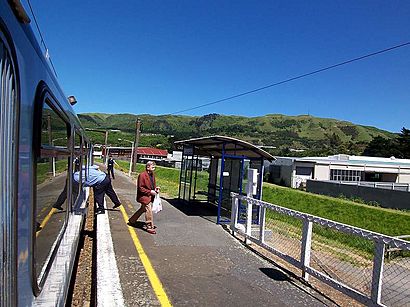Kenepuru railway station facts for kids
Quick facts for kids
Kenepuru
|
|||||||||||
|---|---|---|---|---|---|---|---|---|---|---|---|
| Metlink suburban rail | |||||||||||

Kenepuru in December 2008
|
|||||||||||
| Location | Bell Street, Tawa, Wellington, New Zealand | ||||||||||
| Coordinates | 41°08′58.92″S 174°50′18.6″E / 41.1497000°S 174.838500°E | ||||||||||
| Owned by | KiwiRail (platforms and track); Greater Wellington Regional Council (shelters and footbridge) | ||||||||||
| Line(s) | North Island Main Trunk | ||||||||||
| Platforms | Dual side | ||||||||||
| Tracks | Main line (2) | ||||||||||
| Construction | |||||||||||
| Parking | No | ||||||||||
| History | |||||||||||
| Opened | 28 April 1963 | ||||||||||
| Services | |||||||||||
|
|||||||||||
The Kenepuru railway station is a train stop in Wellington, New Zealand. It's part of the main railway line called the North Island Main Trunk Railway (NIMT). The station has two tracks and platforms on a curved part of the line. It's about 16 kilometers (10 miles) from Wellington railway station, which is the end of the NIMT line. Kenepuru station helps people get to the industrial area of Kenepuru and is close to Kenepuru Hospital.
Contents
What Trains Stop Here?
Trains called the Kapiti Line stop at Kenepuru. These trains are run by Transdev Wellington under the Metlink name. They travel between Wellington and Waikanae. The trains used are modern electric units called Matangi trains.
Two other diesel-powered trains, the Capital Connection and the Northern Explorer, pass through Kenepuru. However, they do not stop at this station.
Train Schedule
During the middle of the day, trains stop at all stations between Wellington and Waikanae. They come every twenty minutes.
During busy times, called "peak periods," some trains from Wellington might end their journey at Porirua or Plimmerton. They then go back to Wellington. Also, some peak trains go straight from Wellington to Porirua without stopping at Kenepuru. At night, trains run less often.
How Long Does it Take?
- It takes about 19 minutes to travel to Wellington by train.
- It takes about 2 minutes to travel to Porirua.
- It takes about 41 minutes to travel to Waikanae.
Station Upgrades
In the past, there was talk about closing Kenepuru station. This was because it didn't have many users and needed a lot of money for upgrades. But in 2011, it was decided the station would stay open. Some small repairs were planned to keep it going for another 10 years.
Over the Christmas break in 2011, the station got a big makeover. Both platforms were redone, and the platform for southbound trains was made stronger. The path to this platform was also improved. This was the first time the station had been refurbished since it opened in 1963. The upgrades cost over $320,000.
Station History
The railway line that runs through Kenepuru was built a long time ago. It was built by the Wellington and Manawatu Railway Company (WMR). The line was finished in 1886. The WMR ran the trains until December 1908. Then, the New Zealand Railways Department bought the line. It became part of the main North Island Main Trunk (NIMT) line.
Changes to the Line
On June 19, 1937, a new section of the railway opened south of Kenepuru. This new part was called the Tawa Flat deviation. It made the journey into Wellington much shorter. Before this, trains had to take a longer route through Johnsonville.
In June 1940, the railway line where Kenepuru station is now was made electric. This meant electric trains could use it. On December 15, 1957, the line was made double-tracked. This allowed trains to travel in both directions at the same time.
Why Kenepuru Station Was Built
When the railway first came through the Kenepuru area, it was mostly farmland. But by 1960, things were changing. The nearby Kenepuru Hospital was being built. More businesses were setting up near the railway. Also, a new housing area called Bell Block was almost finished.
Because of all these new developments, more people wanted a train station in the area. So, Kenepuru station was opened on April 28, 1963. It had a bridge for people to walk over the tracks. People could easily get to the businesses and the hospital on one side. They could also get to Bell Street on the other side. No car parking was built at the station.

